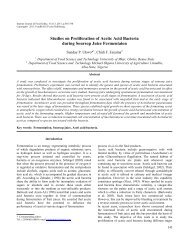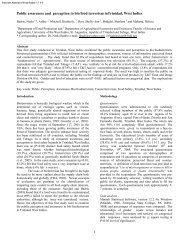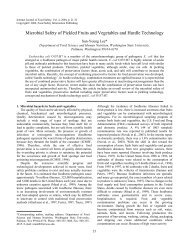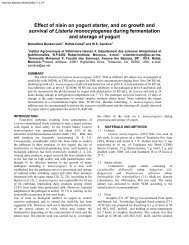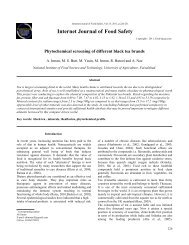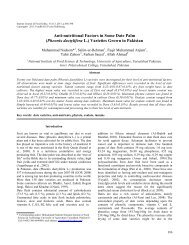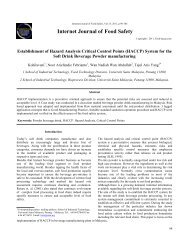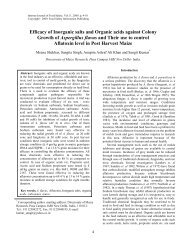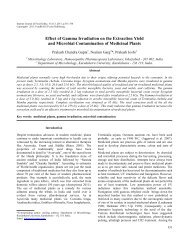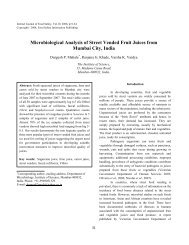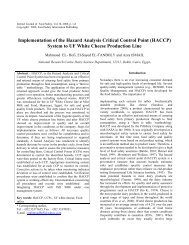Vol 15. 39-47 - Internet Journal of Food Safety = FoodHACCP.com
Vol 15. 39-47 - Internet Journal of Food Safety = FoodHACCP.com
Vol 15. 39-47 - Internet Journal of Food Safety = FoodHACCP.com
Create successful ePaper yourself
Turn your PDF publications into a flip-book with our unique Google optimized e-Paper software.
Conclusion<br />
The findings <strong>of</strong> this study reveal areas <strong>of</strong> improvement<br />
which could be implemented towards attaining safe street<br />
food.<br />
Majority 76 % <strong>of</strong> vending stalls were seen to be clean<br />
which indicates an effort by the vendors to keep their<br />
premises clean. However, there is a need to ensure the stalls<br />
are properly located to prevent the food contamination from<br />
the potential contaminants. Construction materials should<br />
be designed for easier cleaning. Seventy six per cent <strong>of</strong><br />
vendors did not hold food handlers’ medical certificate. It is<br />
re<strong>com</strong>mended that medical screening be carried as a<br />
requirement as any carrier <strong>of</strong> a food pathogen can<br />
contaminate food.<br />
Only 34 % <strong>of</strong> the vendors hand washes their customers.<br />
Most customers were reported to prefer polythene bags and<br />
cutlery instead <strong>of</strong> washing hands. Stalls owners and the<br />
food handlers should be trained to embrace a hand washing<br />
culture to avoid any food contamination. This should<br />
augment already existing media advertisations to embrace<br />
hand washing. Emphasis should be moved from school<br />
children alone to the whole population.<br />
Only 34 % vendors wore protective clothing and majority<br />
could not protect the food from contamination emanating<br />
from their bodies. The wearing <strong>of</strong> protective clothing will<br />
need to be enforced to ensure potential <strong>of</strong> food<br />
contamination is reduced.<br />
There were no customer <strong>com</strong>plaints regarding food safety<br />
signifying a higher level <strong>of</strong> satisfaction by consumers on the<br />
services obtained from these stalls or ignorance altogether.<br />
It could also mean under reporting <strong>of</strong> the <strong>com</strong>plaints.<br />
Training on food hygiene and food safety was lacking in<br />
79 % <strong>of</strong> the vendors. All vendors were women and<br />
consideration can be enhanced by food hygiene training<br />
programs that can be correlated to women participation in<br />
the society.<br />
A total <strong>of</strong> 79 % vendors could let the food cool naturally<br />
and if the food is not purchased and served when hot, there<br />
is potential microbial multiplication if contamination occurs.<br />
A total <strong>of</strong> 90 % vendors use polythene bags to wrap/pack<br />
take away rations. The high frequency <strong>of</strong> usage <strong>of</strong><br />
polythene bags to package food will required these material<br />
evaluated for potential source <strong>of</strong> contamination.<br />
Seventy nine percent; (79 %), (23/29) <strong>of</strong> the vendors used<br />
NCC sanitary facilities. The high level <strong>of</strong> dependence <strong>of</strong><br />
NCC facilities indicates a need to harmonize and provide<br />
services at close proximity to the food vendors and their<br />
clients.<br />
The water is not boiled before serving to customers. Since<br />
some (7 %) <strong>of</strong> this water is not obtained from treated<br />
sources <strong>of</strong> the NCC, then it should be evaluated as a<br />
potential source <strong>of</strong> food contamination. The water can also<br />
be contaminated during vending and could be evaluated.<br />
The out<strong>com</strong>e <strong>of</strong> this study can serve as a baseline data for<br />
management and improvement <strong>of</strong> the street food safety<br />
based on these areas.<br />
From the referenced study (Gitahi at al., 2012), the<br />
vegetable foods the highest total viable counts at 4.71 ±0.3<br />
log 10 cfu/g, highest total coliforms counts at 4.48 log 10 cfu/g<br />
and highest Staphylococcus aureus at 4.03 log 10 cfu/g. All<br />
vegetables were served raw. They were not heat treated and<br />
were held at ambient temperature between preparation and<br />
service.<br />
Vegetables from Ricky road were sourced from Wakulima<br />
market and local groceries and had the highest<br />
Staphylococcus aureus counts <strong>of</strong> 4.69±0.05 log 10 cfu/g.<br />
There was significantly similar (p



